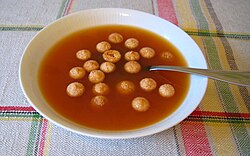 A bowl of rose hip soup with small biscuits made from almonds, sugar, and egg whites. | |
| Alternative names | nyponsoppa |
|---|---|
| Type | Beverage or Soup |
| Course | Breakfast or Dessert |
| Place of origin | Sweden |
| Serving temperature | Cold or Hot |
| Main ingredients | Rose hips, sugar, water, potato starch |
| 83-1,608 kJ per 100g 20-384 kcal per 100g [1] | |

Rose hip soup (Swedish : nyponsoppa) is a Swedish soup made from rose hips. [2] It is served as a beverage or as a dessert with milk, cream or vanilla ice cream along with small almond biscuits.
Contents
Rose hip soup may be eaten for breakfast. The types of soup for that purpose are generally lower in fruit content and more watery, and may be served with pieces of crisp bread.